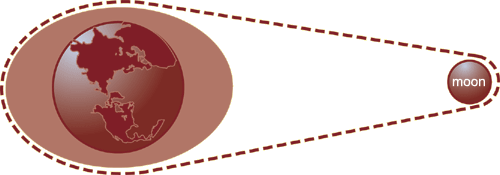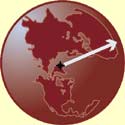Try This!
The tides get later each day
You will need to
print this
page
.
If the link above doesn't work, try typing Ctrl + P on a PC or Apple
+ P on a Macintosh
.
At most places on earth, there are two high tides each day. With each
passing day, the high tides occur about an hour later. The moon rises
about an hour later each day, too (actually, 54 minutes later). Since
the moon pulls up the tides, these two delays are connected. As the earth
rotates through one day, the moon moves in its orbit. A point on the earth
must move a little farther than one rotation to line up with the moon
again.
Materials
• Paper and pencil, or a photocopier
• Scissors
• Corrugated cardboard
• A thumbtack
• A printed copy of this activity
Assembly
• Cut the earth-moon system (below) from the printout you've made
of this activity. Paste it onto heavy paper or tagboard, and cut around
it. Leave the moon connected to the planet by cutting along the dotted
lines. (Note: If this were a true scale drawing of the earth and moon,
the moon would be an arm’s length, 75 centimeters, away. The heights
of the tidal bulges are also greatly exaggerated.)

• Do the same thing with this view of the earth from above the north
pole.

• Get a piece of corrugated cardboard about the size of a piece of
typing paper. Put the earth-moon model on top of the cardboard. Put the
north pole view of the earth on top of the earth-moon model. Push a thumbtack
through the center of the earth image, then through the center of the
earth on the earth-moon image, into the cardboard.
To Do and Notice
• Rotate the planet counterclockwise while looking at the tides.
Notice that in this idealized model, any spot on the surface of the earth
rotates under two high tides each day.
• Set the earth so that the Greenwich meridian, indicated by the
arrow, points toward the moon. (The Greenwich meridian, or prime meridian,
is a line of longitude that passes through Greenwich, England.) In our
simple model, the tide at Greenwich (at the tip of the arrow) is high.
• Rotate the earth through one full solar day, so that the Greenwich
meridian goes around in one full circle.
• During one day, the moon moves about 13 degrees in its orbit. Move
the moon 13 degrees counterclockwise without moving the earth, and notice
that the location of the high tide is no longer directly over Greenwich.
• Rotate the earth through an additional 13 degrees to place Greenwich
at the location of the high tide. This takes 54 minutes. So the high tides
occur 54 minutes later each successive day.